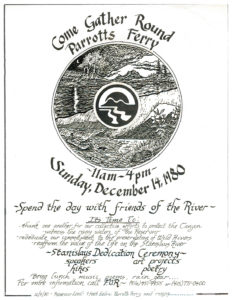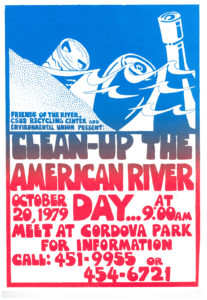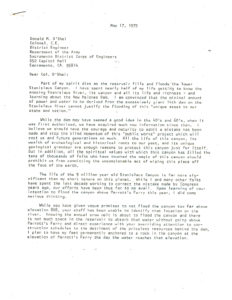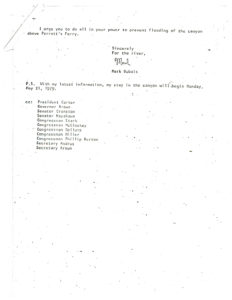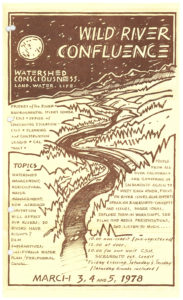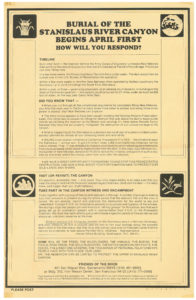When we try to pick out anything by itself, we find it hitched to everything else in the Universe.
— John Muir (1838-1914) from My First Summer in the Sierra
On October 2, 1968, the Wild and Scenic Rivers Act was passed by Congress, creating a system of rivers throughout the country to be preserved for generations to come. For the environmental movement gaining momentum in the 1960s this was an important turning point for water protection – although the waterways deemed valuable enough to conserve did not include the Stanislaus River in Northern California, already slated for a large, new dam to be built by the Army Corp of Engineers. The impending filling of the reservoir would cause a 13 mile unimpeded stretch of the river to rise, bringing about the destruction and loss of numerous cultural resources and a highly accessible white water rafting area. Supporters of the dam argued that the New Melones Dam project would create construction jobs, increase the state’s water supply, help with flood control and generate hydroelectric power.
In 1973, a small group of individuals including Gerald “Jerry” H. Meral, Rob Caughlan, David Oke and David Kay decided to form a grassroots conservation organization called Friends of the River to gather signatures to put the Proposition 17 initiative on the ballot thereby adding the Stanislaus River to the list of protected rivers. Though the initiative was placed on the 1974 ballot in California and received significant support from river rafters, environmentalists and others who valued the river as it was, the initiative ended up failing in the election. This defeat didn’t suppress the spirit of the Friends of the River and the group was incorporated in 1975 as the Friends of the River Foundation, a non-profit membership based organization dedicated to river protection under the leadership of Mark Dubois and Jennifer Jennings.
By 1978, the New Melones Dam construction was completed and the spillway and powerhouse were in place in 1979. In May 1979, when the lake was about to be filled with water, Mark Dubois sent a four paragraph typed, signed letter to Colonel Donald M. O’Shei, the Army Corps of Engineers’ Sacramento District Engineer, warning of his impending action to attempt to halt the filling of the New Melones reservoir by hiding in the canyon and chaining himself to a rock in the river. This act of defiance by Dubois brought considerable attention to the already well publicized project and the filling of the lake was halted temporarily.
Though the New Melones reservoir was eventually filled in 1982, one of the campaign’s most influential achievements was to crack open the debate about the cost effectiveness and benefits to society of large dam projects around the globe. No other dams of this magnitude have been constructed in the United States since the completion of the New Melones Dam and the struggle to save the Stanislaus River from the construction of the New Melones Dam remains one of the greatest examples of citizen involvement in American history to stop a dam from being built. The Friends of the River Foundation continues to push for water protection legislation in California through grassroots organizing, public outreach and education.
The Friends of the River Foundation records are now open to researchers at The Bancroft Library. The processing of the Friends of the River Foundation records is part of a two-year grant project funded by the National Historical Publications and Records Commission to make available a range of archival collections relating to environmental movements in the West. A leading resource in the documentation of U.S. environmental movements, The Bancroft Library is home to the records of many significant environmental organizations and the papers of a range of environmental activists.
